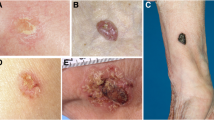Abstract
Objectives: Because the factors that influence risk of acral melanomas on the soles and palms in White populations are unknown, we investigated these in a multi-center case-control study.
Methods: Cases of melanoma of the feet and hands diagnosed from 1987–93 in persons aged over 18 years were ascertained in eastern Australia and western Scotland. There were 275 cases of melanoma on the soles and palms matched to 496 controls (selected from the electoral roll) in Australia, and 36 cases matched to 72 controls (nominated by general practitioners) in Scotland.
Results: Acral melanoma was strongly associated with high total body nevus counts (adjusted relative risk [RR]=6.3, 95% confidence interval [CI]=2.5–15.6), and with nevi on the soles (RR=7.5, CI=3.0–18.6). There were also significant positive associations with a penetrative injury of the feet or hands (RR=5.0, CI=3.0–8.6) and with heavy exposure to agricultural chemicals (RR=3.6, CI=1.5–8.3). Sun-sensitive complexions, cumulative sun exposure and a past history of nonmelanoma skin cancer were also associated with increased risk of acral melanoma. Current cigarette smoking was inversely related to acral melanoma (RR=0.6, CI=0.4–0.9).
Conclusions: Melanomas of the soles and palms resemble other cutaneous melanomas in their association with sun exposure, but are distinguished from them by their strong positive associations with nevi on the soles, previous penetrative injury, and exposure to agricultural chemicals, and by their inverse association with smoking.
Similar content being viewed by others
References
Stevens N, Liff J, Weiss N (1990) Plantar melanoma: is the incidence of melanoma on the sole really higher in blacks than whites? Int J Cancer 45: 691-693.
Dwyer P, MacKie RM, Watt DC, Aitchison TC (1993) Plantar malignant melanoma in a white Caucasian population. Br J Dermatol 128: 115-120.
Coleman W, Loria P, Reed R, Krementz E (1980) Acral lentiginous melanoma. Arch Dermatol 116: 773-776.
Rolon PA, Kramarova E, Rolon HI, Khlat M, Parkin DM (1997) Plantar melanoma: a case-control study in Paraguay. Cancer Causes Control 8: 850-856.
MacKie R, Hunter JAA, Aitchison TC, et al. (1992) Cutaneous malignant melanoma, Scotland, 1979–89. Lancet 339: 971-975.
International Agency for Research on Cancer (1992) Solar and Ultraviolet Radiation. IARC Monogr Eval Carcinog Risks Humans, Vol. 55. Lyon: IARC, 99-228.
Golledge J (1997) Lower-limb arterial disease. Lancet 350: 1459-1465.
Hughes BR, Cunliffe WJ, Bailey CC (1989) The development of excess numbers of benign melanocytic naevi in children after chemotherapy for malignancy. Br Med J 299: 88-91.
Green A, Smith P, McWhirter W, et al. (1993) Melanocytic naevi and melanoma in survivors of childhood cancer. Br J Cancer 67: 1053-1057.
Lee JAH, Merrill JM (1970) Sunlight and the aetiology of malignant melanoma: a synthesis. Med J Aust 2: 846-851.
Author information
Authors and Affiliations
Rights and permissions
About this article
Cite this article
Green, A., McCredie, M., MacKie, R. et al. A case-control study of melanomas of the soles and palms (Australia and Scotland). Cancer Causes Control 10, 21–25 (1999). https://doi.org/10.1023/A:1008872014889
Issue Date:
DOI: https://doi.org/10.1023/A:1008872014889




